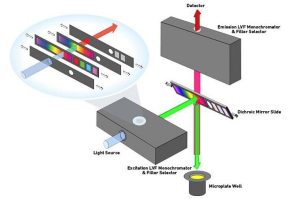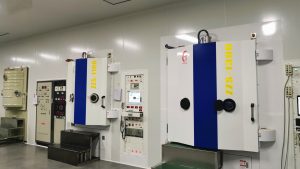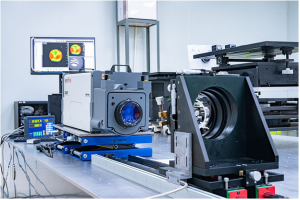Enzyme-linked immunosorbent assay (ELISA) can be divided into two types according to the different filtering methods: filters based ELISA and grating based ELISA. Enzyme-linked immunosorbent assay (ELISA) is a professional medical device that reads and analyzes the results of enzyme-linked immunosorbent assay (ELISA) experiments. It is widely used in clinical testing, biological research, agricultural science, food and environmental science. The classification method of enzyme-linked immunosorbent assay can generally be divided according to different filtering methods and functions.

Principle of enzyme-linked immunosorbent assay filter:
The filter is an optical film coated on optical glass. When an optical film layer is added, regarding the interference principle of light, the refractive index of the filter changes, resulting in a change in the passage of wavelength by the filter. For example, a 485/20nm filter can allow light with wavelengths ranging from 475nm to 495nm to pass through, and light outside this wavelength range will be blocked and absorbed.
In the enzyme-linked immunosorbent assay, a light source will be emitted from a xenon or halogen tungsten lamp, separated by a specific filter to separate unwanted wavelengths, and then irradiated into the sample. The fluorescent dye in the sample will be excited, emitting light, and then separated from the stray light through a specific filter, which will be collected by the detector. This is the fluorescence detection process of the filter system enzyme-linked immunosorbent assay.
The principle of enzyme-linked immunosorbent grating:
In order to solve the problem of the filter system not being able to change the wavelength at any time, grating type enzyme labeling instruments have emerged. It uses the principle of physical diffraction gratings to separate white light sources into independent wavelengths at different angles, and then separates the selected excitation wavelengths through a series of slits and irradiates them onto the sample. The emitted light of the sample is also separated by the same principle to determine the required wavelength, which is finally received and measured by the detector.
Comparison of the differences between gratings and filters
a. Comparison of Purity Differences in Enzyme Labeling Instrument Light
High purity light is preferred for photoelectric detection, but no matter which type of splitter is used, absolute pure light cannot be obtained
Grating: In terms of the point after the grating divides the light, the light is pure, but due to the certain width of the transparent hole, the light received by the colorimetric dish is an equal intensity light in the wavelength band near the specified wavelength.
2. Filter: after light separation by the filter, the light received by the cuvette through the light transmission hole is also a wave band, but the light intensity at the specified wavelength is the highest, showing a normal distribution.
b. Comparison of the Stability Differences of Enzyme Labeling Instrument Light
1. Grating: The rotation of a prism or grating around an axis can cause significant deviation due to inevitable mechanical errors and small angle deviations that are reflected 2-3 times, resulting in wavelength instability. In addition, the grating is narrow and its energy is also very weak. In order to obtain a large voltage value, a small detection voltage signal must be amplified by a large factor, which will also amplify the error and cause instability in the detection
2. Filter: Due to the fact that the wavelength of the light passing through each point on the same filter is the same, and each position is accurately located through the optical couple, which is not affected by the mechanical error of the instrument itself. Therefore, after the light intensity is converged, the energy is high, and the voltage signal is relatively strong. The mainstream light is strong, and the influence of other stray light is weak and can be ignored. The error is also small, and the light is stable, so the detection is relatively stable
c. The difference in the later maintenance of the enzyme marker equipment is the grating: once screws become loose, transmission errors occur, and the light bulb is replaced, resulting in a deviation of the center wavelength, it is generally difficult to adjust the appropriate position again. It must be debugged by professional manufacturers using professional equipment. In fact, most users in China do not receive training and notification in this field, so after a year of use, if there is a deviation, they will not go to the manufacturer for calibration.
2. Filter: Simple structure, easy to maintain. Maintenance can be completed with a little training.
d. Differences in sensitivity of enzyme-linked immunosorbent assay instruments:
1. The filters has a very good transmittance of over 85%, which means that the loss of light energy is relatively small. As shown in Figure 1, in a fluorescence detection, there is only a small loss (approximately 10%) of excitation light entering the sample through the filter and emission light entering the detector from the sample through the filter. The loss of light is relatively small, the energy of light is naturally large, and the fluorescence signal is naturally easy to detect. This is the initial guarantee for obtaining high signal-to-noise ratio (SNR). Therefore, due to its high signal-to-noise ratio (SNR) guarantee, the filter system has always been the gold standard for high sensitivity detection since the birth of the enzyme-linked immunosorbent assay (ELISA). It is not difficult to find that many manufacturers with grating type enzyme labeling instruments have additional filter module designs in high-end applications with high detection sensitivity requirements, such as TRF, TR-FRET, etc. Due to these high-end applications, grating systems have not achieved satisfactory results or simply cannot be achieved.
2. The grating system brings convenience, but it also has some drawbacks. Based on the issue of optical path design, the optical energy loss of the grating is much greater than that of the filter. In fluorescence detection, the excitation light generated by the light source passing through the grating has less energy than the original one. After the sample is excited, it will emit light, which will pass through the grating to separate the required wavelengths. The energy of the emitted light after being separated is lost again. The sensitivity of the grating enzyme-linked immunosorbent assay is not as good as that of the filter enzyme-linked immunosorbent assay, so in high-end grating enzyme-linked immunosorbent assay, a filter module is also required to perform high sensitivity requirements such as TRF and TR-FRET.



